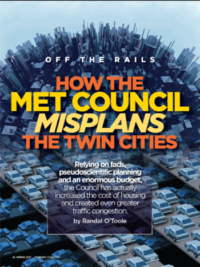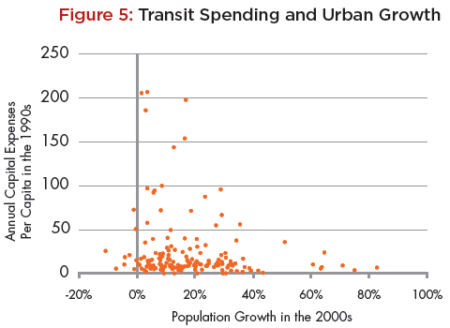All the reasons the Met Council screwed up $BIG TIME by forcing light rail

The latest issue of the Center’s fantastic quarterly magazine, Thinking Minnesota, has a terrific piece by transportation expert Randal O’Toole that delineates all the reasons the Met Council screwed up BIG TIME by forcing light rail on everyone. If you didn’t receive your issue in the mail be sure to send your name and address to [email protected] to get your FREE subscription.
Fun facts revealed include that the word “light” in light rail doesn’t refer to weight (light-rail cars weigh more than heavy-rail cars) but to capacity as light rail is, by definition, low-capacity transit. Also, for the same cost as the North Star trains, the Met Council could have given every round-trip commuter a brand new Toyota Prius … every year … for 30 years!

Informative nuggets from the report:
The Met Council’s supposedly expert planning has produced unaffordable housing, growing traffic congestion, a misallocation of scarce resources to obsolete transportation systems, and efforts to socially engineer a massive change in lifestyles to fit planners’ ideologies. . . .
Long-range planning for all these resources is simply more than anyone can handle. Planners can’t accurately foresee the future needs and desires of millions of people or successfully prescribe the optimal land use for each of hundreds of thousands of acres of land. Therefore, Met Council planners rely, instead, on fads and pseudoscientific planning.
One of those fads is urban-service boundaries that supposedly make housing and land uses more efficient. Yet in fact, by limiting the land available for housing, the Met Council’s service boundary makes it more expensive.
According to Coldwell Banker, a four-bedroom, two-bath, 2,200-square-foot home in Indianapolis costs about $202,000. That same home in Minneapolis costs $650,000, while a similar home in St. Paul is $370,000. Prices of commercial, retail, and other forms of real estate are also relatively high and help explain why the Indianapolis urban area is growing twice as fast as the Twin Cities.
Another urban-planning fad is to deal with traffic congestion by ignoring it. Planners believe that automobiles are evil and doing things that relieve congestion simply encourages their use. Therefore, they allow congestion to grow in the hope that a few people will stop driving their own vehicles and start riding transit.
But congestion has tripled since 1982
The Met Council would like people to believe that light rail, another planning fad, relieves congestion. Yet in fact, it makes congestion worse, both because it occupies more space on city streets than the few cars it replaces and because it disrupts traffic signals whenever it crosses streets.
In 2015, light rail carried less than half a percent of Twin Cities commuters to work. … The Hiawatha light-rail line never crosses Hiawatha Avenue, but it crosses streets that cross Hiawatha, and because the signals for those crossings are coordinated with the signals for Hiawatha, the light-rail line has added 20 to 40 minutes to people’s travel times between Minneapolis and Bloomington.
Metro Transit’s light rail is an expensive but obsolete monument to political egos. … By 1972, all but eight cities had replaced rail transit with buses that were faster, safer, more flexible, and far less expensive.
In 1973, however, Congress began providing funds for cities to build new rail transit lines. This led to the creation of a rail transit lobby consisting of railcar manufacturers and rail contractors enriching themselves by promoting yesterday’s transportation for tomorrow’s cities. Were it not for the attraction of “free” federal money, the Twin Cities would almost certainly have no light rail today.
The Twin Cities doesn’t even need high-capacity transit
Despite the false claim that light rail is superior to buses because it is “high-capacity transit,” the Twin Cities doesn’t even need high-capacity transit. In 2013, during afternoon rush hours, the Hiawatha Line carried fewer than 2,900 people per hour. Morning rush-hour ridership was even lower at under 2,200 people per hour. These numbers could easily be carried by rapid buses at a tiny fraction of the cost of rail.
True high-capacity transit is only necessary when there are large numbers of jobs concentrated in a central location. Lower Manhattan, for example, has nearly 2 million jobs, or more than 20 percent of all jobs in the New York metropolitan area. In contrast, less than ten percent of jobs in the Twin Cities are in downtown Minneapolis. The vast majority of jobs in the region are so finely spread out that they can be served only by buses, if transit can work for them at all.
Rail advocates argue that buses can get caught in congestion. But it would be better to spend scarce resources trying to relieve congestion for everyone than to build rail-transit lines used by relatively tiny numbers of people that actually make congestion worse for everyone else.
Astronomical cost to build and maintain
According to a 2008 Federal Transit Administration report comparing projected costs with actual costs of rail projects, the Hiawatha light-rail line was originally supposed to cost $244 million. After adjusting for inflation, it actually cost $697 million. …
Before it was built, planners also estimated that the Hiawatha Line would cost $12 million a year to operate. In its first year, it cost $16 million. By 2013, the last year before the Green Line opened, operating costs had ballooned to more than $32 million a year, plus another $5 million for maintenance.
Folly for a few, at the expense of the many
In 2015, all of the region’s transit put together carried a bit more than one percent as many passenger miles of travel each year as the region’s automobiles. Yet the Met Council’s 2040 transportation plan proposes to spend three times as many dollars on transit capital improvements as on highway improvements. …
Rather than design a transportation system that works for the Twin Cities, the Met Council’s goal is to reshape the Twin Cities to support the system it is building. That means increasing population densities in transit corridors by building four- and five-story housing complexes known as transit-oriented developments, which is another urban-planning fad. Many of these are mixed-use, meaning they have retail on the ground floor and residences above so that people can walk to shops instead of drive and then take light rail or commuter rail to work.
Most Americans don’t really want to live that way. … [F]ar from promoting economic development, rail transit and tax-increment financing at best merely influence where development will take place and at worst actually slow growth because of increased tax burdens.
Met Council ignores coming transportation revolution of self-driving cars
Although the Met Council supposedly looks 25 years into the future, so far its plans have ignored the next transportation revolution: the autonomous or self-driving car. Autonomous cars will have at least as big an impact on cities and their residents in the next century as Henry Ford’s mass-produced cars had in the last century.
For example, autonomous cars will change the way we view the time spent traveling because people will be able to work, read, or watch entertainment instead of the road while commuting. …
Since automobiles are far more efficient than transit, such cars will take people door-to-door at prices competitive with transit fares, thus rendering transit completely obsolete and thus saving taxpayers the huge subsidies now paid to run transit lines.
Even if Ford is a year or two late on its promise [fully self-driving cars by 2021], it makes no sense for the Twin Cities to spend billions on the Southwest light rail and other expensive transit projects when autonomous cars will soon take away most of their riders. Nor does it make sense for the region to subsidize high-density developments when people seeking affordable housing can simply escape outside of the region of the Met Council’s influence.
Met Council is “planning for the past”
In failing to foresee autonomous cars, Met Council planners have given up all credibility for their work. Rather than plan for the future, they are planning for the past. Few Americans want to live in this past, because it would mean higher housing costs, higher transportation costs, and more inequality as only the affluent have mobility and spacious private homes. Paying for this vision of the past also means higher taxes and slower economic growth.
Peter Zeller is Director of Operations at Center of the American Experiment.